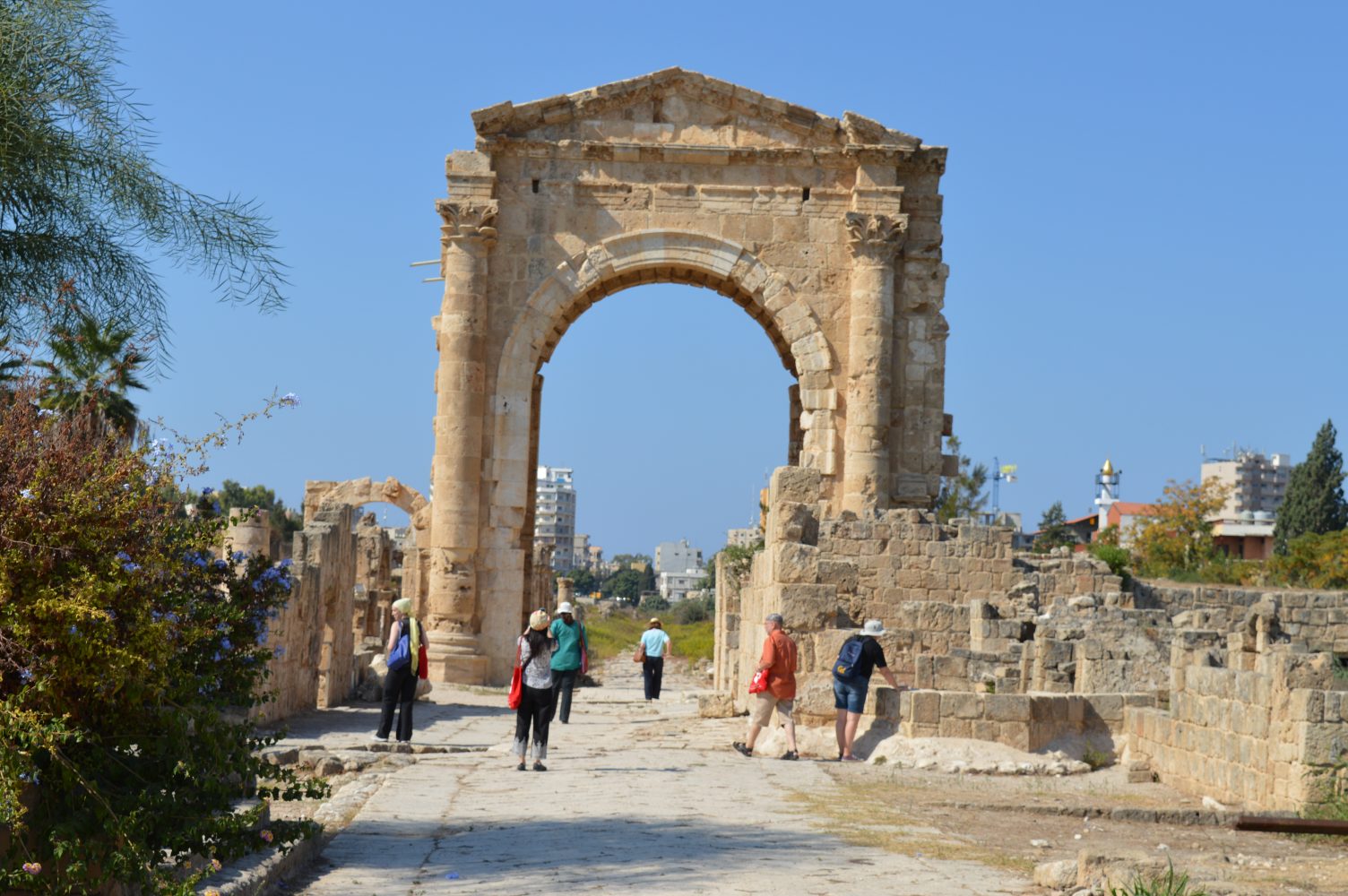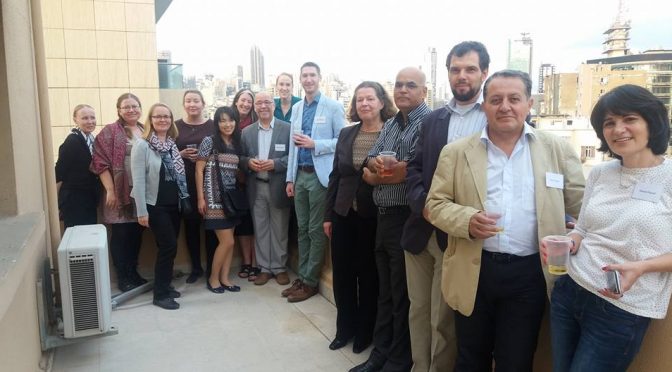Laura Wickström
Laura Wickström works as coordinator at FIME’s office in Beirut October 2015 – November 2016. She is a doctoral student at Åbo Akademi University and holds a Master of Arts degree in comparative religion and currently specializes in Islam and ecology within the Department of Comparative Religion.
The conference Religion and Empire in the First Millennium BCE Levant took place in Beirut, Lebanon, in October 2016. The three-day conference with excursions was jointly organized by the Academy of Finland Centre of Excellence in “Changes in Sacred Texts and Traditions” at the University of Helsinki (CSTT), the Finnish Institute in the Middle East (FIME), and the Department of History and Archaeology at the American University of Beirut (AUB).
As Dr. Helen Dixon from the CSTT clearly presented, the structure of the Centre of Excellence CSTT consists of four research teams (Society and Religion in the Ancient Near East, Text and Authority, Literary Criticism in the Light of Documented Evidence, and Society and Religion in Late Second Temple Judaism). The scholars presenting papers at the conference were all part of the Team 1 “Society and Religion in the Ancient Near East”, which, with some generalizations, could further be divided into three research clusters: Assyriologists, Archaeologists, and Levantine Exegetes (dealing with texts and images).
The American University of Beirut was a convenient choice for several reasons for the conference venue. For most of the international participants it was the first visit to Lebanon, even though many of the researchers have spent time conducting fieldwork in neighboring countries. Considering the current regional situation and the relative isolation of Lebanon, many locals in the audience and participators commented and thanked the organizers for the international presence of researchers and for coming to Lebanon to show support for such an important field of research.
One should never underestimate the importance of coffee breaks and time spent on excursions, those are the moments beside the scholarly discussions within the lecture hall when new acquaintanceships are formed and friendships deepened. One of the reasons for arranging conferences abroad is the potential for contacts. To borrow the expression from Dr. Izaak de Hulster from CSTT, may “the contacts initiated with the Lebanese colleagues last and become fruitful”.
Considering how magnificent the archeological sites are in Lebanon, such as the Temple of Eshmun / Bustan esh-Sheikh outside of Sidon and the el-Mina and al-Bass sites in Tyre, that were all part of the excursions during the conference, visiting them increased understanding of the Phoenicians and their position, role, and impact in the region during the first millennium BCE. The Temple of Eshmun was devoted to the head or royal god of the city of Sidon, Eshmun, and the highlight of the site in present time is the throne of Astarte.
As excellent preparations for the excursions, Professor Leila Badre, the Director of AUB Archaeological Museum, gave a keynote on the rediscovery of the Tyre temple and professor Hélène Sader, AUB, gave a keynote on how the Phoenicians resisted cultural influence from the Assyrian Empire. Listening to Professor Sader’s presentation on how the Phoenicians, regarded as ancestors by many Lebanese, persisted foreign powers, there was something very familiar with the situation of the current time.

The archaeological sites in Tyre are divided into three parts; el-Mina (areas 1 and 2) and al-Bass. Al-Bass contains e.g. a funerary complex, with hundreds of ancient sarcophagi, a Roman road, an archway and the largest Roman hippodrome in the world. The hippodrome could hold more than 20,000 spectators. Among the ruins at el-Mina a mosaic street with rows of columns on both sides can be found.
The visit to the Beirut National Museum was the revelation of a long-awaited site; the basement exhibition with invaluable sarcophagi and mummies had reopened only two weeks before the conference for the first time since the Lebanese Civil War (1975 – 1990). There are 29 anthropoid sarcophagi in the museum, as the French scholar and specialist in Semitic philology Ernest Renan called this distinctive type of burial tradition of the Phoenician mainland. The anthropoid sarcophagis are found along the coast of Lebanon in sites such as Tyre, Sidon, Byblos (Jebeil), and Aradus (Ruad). The anthropoid sarcophagis from Sidon derive from the 5th to 4th centuries BC and each anthropoid sarcophagi reproduces the idealized features of the Sidonian man or woman who ordered the anthropoid sarcophagi during his or her lifetime. (These facts from a booklet on the Beirut National Museum authored by Nina Jidejian)
For someone doing research on the contemporary Middle East, Dixon’s presentation was a good reminder of which dominant empires had power in the region in the first millennium BCE: the Neo-Assyrian Empire (ca. 911 – 605 BCE), the Neo-Babylonian Empire (ca. 600 – 539 BCE), the Achaemenid Empire (ca. 539 – 332 BCE), and the Hellenistic (Seleucid/Ptolemaic) Empires (ca. 330 – 65 BCE). While the dominant empires changed, the Phoenicians preserved to a large extent their own culture and way of living.
Dixon further asked the questions that set the frame for the conference; what is an empire, what do empires care about, how do empires work and when do empires collapse? Situated in the land of the ancient Phoenicians, questions such as whether the impact of empires are “good” or “bad” and how smaller states survive empires were particularly relevant.
One answer to these questions could be found in the presentation concerning coins given by Dr. Jack Nurpetlian from the History and Archaeology Department at AUB. Assuming that the influence of the Hellenistic Empire was as overbearing as we tend to think, there is, however, not much evidence of this in the coins found from this particular era. The Phoenicians, for example, preserved their gods and rulers on their coins, which in the context of the first millennium BCE, meant that the figures on the coins were not insignificant but rather gave the clearest demarcation of power and priorities in the society. The questions raised were, whether there have not been coins found with gods or rulers from the Hellenistic time, or there have not been any coins with these motifs. Sometimes the lack of evidence is the evidence.

